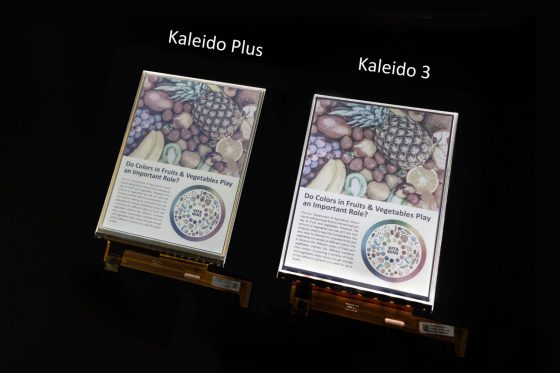A couple days ago E Ink issued a press release announcing the release of their next generation color displays called Kaleido 3.
They don’t really give many details about the improvements; they just say color saturation has increased by 30 percent compared to their previous generation Kaleido Plus screens, but they don’t say under what lighting conditions.
The new Kaleido 3 screens are available in several common sizes, including 7.8-inches, 10.3-inches, and 13.3-inches.
The Kaleido 3 screens still support 16 levels of grayscale and 4096 colors like previous iterations, and it’s still a black and white screen with a color filter array placed over the top so the color resolution is considerably lower (100 ppi) than the black and white resolution (300 ppi).
The new screens also have a new and improved frontlight designed by E Ink called ComfortGaze that’s supposed to reduce the amount of blue light reflected off the screen.
They fail to give any details beyond that, but you can see a difference in the picture above, although the screen on the right appears to have more light on it so it’s hard to tell for sure.
Apparently this means the new Onyx Boox Nova Air C that was just released last month is already outdated because Onyx says it uses a Kaleido Plus screen with E Ink’s On-Cell touchscreen. Knowing Onyx, they’re probably already working on a replacement for the Nova Air C that uses E Ink’s new Kaleido 3 screen.


Looks good! Just wish they’d work on increasing the dpi.
I think if they ever produce these with either a 450 or 600 dpi base, the overall perceived density would push these over the hesitance barrier for many applications. Most newspapers or textbooks are produced at lower densities. Saturation may not match other displays, would not be suitable for the medical field, but many technical fields would benefit from this type of display.
I’m curious what’s going on with power consumption on these color e-inks in general?
They’re just a regular black and white screen with a color filter on top of the screen, so the color itself has no effect on battery life, other than the fact it requires more full page refreshing to minimize ghosting.
The colour resolution has been increased to 150dpi.
I think it’s more likely a mistake in the video you linked to than an actual improvement because why wouldn’t they have mentioned a 50% resolution increase in the press release, and that doesn’t make sense with how the color filter layer works. The base resolution would have to increase as well.
yet on the picture it looks more crisp isn’t it?